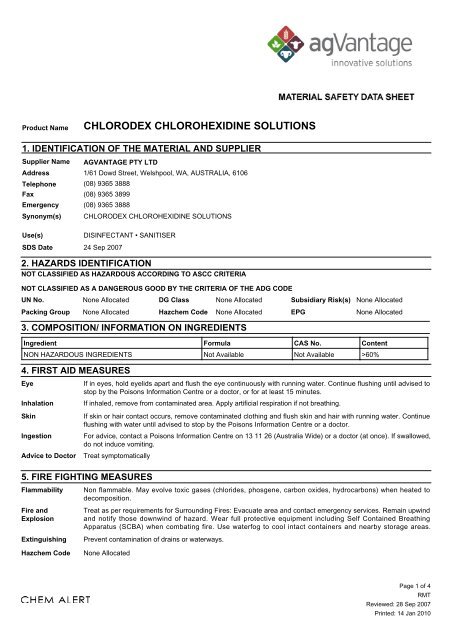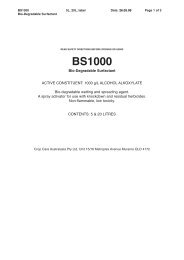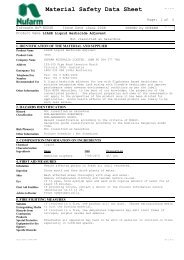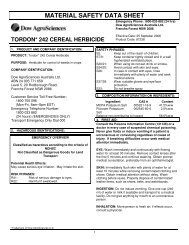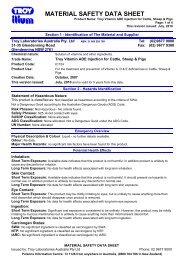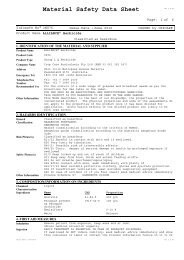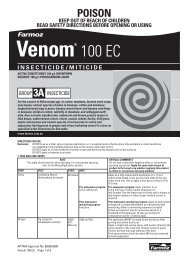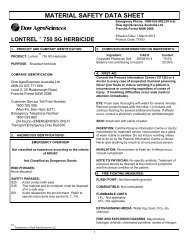214134 Chlorodex farm disinfectant. MSDS - Agsure
214134 Chlorodex farm disinfectant. MSDS - Agsure
214134 Chlorodex farm disinfectant. MSDS - Agsure
You also want an ePaper? Increase the reach of your titles
YUMPU automatically turns print PDFs into web optimized ePapers that Google loves.
Product Name<br />
CHLORODEX CHLOROHEXIDINE SOLUTIONS<br />
1. IDENTIFICATION OF THE MATERIAL AND SUPPLIER<br />
Supplier Name<br />
Address<br />
Telephone<br />
Fax<br />
Emergency<br />
Synonym(s)<br />
AGVANTAGE PTY LTD<br />
1/61 Dowd Street, Welshpool, WA, AUSTRALIA, 6106<br />
(08) 9365 3888<br />
(08) 9365 3899<br />
(08) 9365 3888<br />
CHLORODEX CHLOROHEXIDINE SOLUTIONS<br />
Use(s)<br />
SDS Date<br />
DISINFECTANT • SANITISER<br />
24 Sep 2007<br />
2. HAZARDS IDENTIFICATION<br />
NOT CLASSIFIED AS HAZARDOUS ACCORDING TO ASCC CRITERIA<br />
NOT CLASSIFIED AS A DANGEROUS GOOD BY THE CRITERIA OF THE ADG CODE<br />
UN No.<br />
Packing Group<br />
None Allocated DG Class None Allocated Subsidiary Risk(s) None Allocated<br />
None Allocated Hazchem Code None Allocated EPG<br />
None Allocated<br />
3. COMPOSITION/ INFORMATION ON INGREDIENTS<br />
Ingredient Formula CAS No. Content<br />
NON HAZARDOUS INGREDIENTS Not Available Not Available >60%<br />
4. FIRST AID MEASURES<br />
Eye<br />
Inhalation<br />
Skin<br />
Ingestion<br />
Advice to Doctor<br />
If in eyes, hold eyelids apart and flush the eye continuously with running water. Continue flushing until advised to<br />
stop by the Poisons Information Centre or a doctor, or for at least 15 minutes.<br />
If inhaled, remove from contaminated area. Apply artificial respiration if not breathing.<br />
If skin or hair contact occurs, remove contaminated clothing and flush skin and hair with running water. Continue<br />
flushing with water until advised to stop by the Poisons Information Centre or a doctor.<br />
For advice, contact a Poisons Information Centre on 13 11 26 (Australia Wide) or a doctor (at once). If swallowed,<br />
do not induce vomiting.<br />
Treat symptomatically<br />
5. FIRE FIGHTING MEASURES<br />
Flammability<br />
Fire and<br />
Explosion<br />
Extinguishing<br />
Hazchem Code<br />
Non flammable. May evolve toxic gases (chlorides, phosgene, carbon oxides, hydrocarbons) when heated to<br />
decomposition.<br />
Treat as per requirements for Surrounding Fires: Evacuate area and contact emergency services. Remain upwind<br />
and notify those downwind of hazard. Wear full protective equipment including Self Contained Breathing<br />
Apparatus (SCBA) when combating fire. Use waterfog to cool intact containers and nearby storage areas.<br />
Prevent contamination of drains or waterways.<br />
None Allocated<br />
Page 1 of 4<br />
RMT<br />
Reviewed: 28 Sep 2007<br />
Printed: 14 Jan 2010
Product Name<br />
CHLORODEX CHLOROHEXIDINE SOLUTIONS<br />
6. ACCIDENTAL RELEASE MEASURES<br />
Spillage<br />
If spilt/ containers damaged (bulk), use personal protective equipment. Contain spillage, then collect and place in<br />
suitable containers for disposal. Prevent spill entering drains or waterways.<br />
7. STORAGE AND HANDLING<br />
Storage<br />
Handling<br />
Store in a cool, dry, well ventilated area, removed from foodstuffs. Ensure containers are adequately labelled,<br />
protected from physical damage and sealed when not in use.<br />
Before use carefully read the product label. Use of safe work practices are recommended to avoid eye or skin<br />
contact and inhalation. Observe good personal hygiene, including washing hands before eating. Prohibit eating,<br />
drinking and smoking in contaminated areas.<br />
8. EXPOSURE CONTROLS/ PERSONAL PROTECTION<br />
Exposure Stds<br />
No exposure standard(s) allocated.<br />
Biological Limits<br />
Engineering<br />
Controls<br />
PPE<br />
No biological limit allocated.<br />
Avoid inhalation. Use in well ventilated areas. Where an inhalation risk exists, mechanical extraction ventilation is<br />
recommended.<br />
Wear splash-proof goggles and rubber or PVC gloves. When using large quantities or where heavy contamination<br />
is likely, wear: coveralls.<br />
9. PHYSICAL AND CHEMICAL PROPERTIES<br />
Appearance CLEAR RED LIQUID Solubility (Water) SOLUBLE<br />
Odour ALCOHOL ODOUR Specific Gravity 1.0<br />
pH 6.0 to 8.0 % Volatiles < 1 %<br />
Vapour Pressure NOT AVAILABLE Flammability NON FLAMMABLE<br />
Vapour Density NOT AVAILABLE Flash Point NOT RELEVANT<br />
Boiling Point NOT AVAILABLE Upper Explosion Limit NOT RELEVANT<br />
Melting Point NOT AVAILABLE Lower Explosion Limit NOT RELEVANT<br />
Evaporation Rate<br />
NOT AVAILABLE<br />
10. STABILITY AND REACTIVITY<br />
Chemical Stability<br />
Stable under recommended conditions of storage.<br />
Conditions to Avoid<br />
Material to Avoid<br />
Decomposition<br />
Hazardous Reactions<br />
Avoid heat, sparks, open flames and other ignition sources.<br />
Compatible with most commonly used materials.<br />
May evolve toxic gases (chlorides, phosgene, carbon oxides, hydrocarbons) when heated to<br />
decomposition.<br />
Polymerization will not occur.<br />
11. TOXICOLOGICAL INFORMATION<br />
Health Hazard<br />
Summary<br />
Eye<br />
Inhalation<br />
Skin<br />
Ingestion<br />
Use safe work practices to avoid eye or skin contact and inhalation. Chronic exposure or exposure by individuals<br />
with sensitive skin may result in dermatitis. Upon dilution, the potential for adverse health effects may be reduced.<br />
Contact may result in irritation, lacrimation, pain, redness and conjunctivitis. May result in burns with prolonged<br />
contact.<br />
Over exposure to vapours may result in respiratory irritation, nausea, dizziness and headache. Low vapour<br />
pressure may reduce the likelihood of inhalation.<br />
Contact may result in drying and defatting of the skin, rash and dermatitis. May cause sensitisation by skin<br />
contact.<br />
Ingestion of large quantities may result in nausea, vomiting and gastrointestinal irritation.<br />
Page 2 of 4<br />
RMT<br />
Reviewed: 28 Sep 2007<br />
Printed: 14 Jan 2010
Product Name<br />
Toxicity Data<br />
CHLORODEX CHLOROHEXIDINE SOLUTIONS<br />
No LD50 data available for this product.<br />
12. ECOLOGICAL INFORMATION<br />
Environment<br />
Limited ecotoxicity data was available for this product at the time this report was prepared. Ensure appropriate<br />
measures are taken to prevent this product from entering the environment.<br />
13. DISPOSAL CONSIDERATIONS<br />
Waste Disposal<br />
Legislation<br />
For small amounts absorb with sand, vermiculite or similar and dispose of to an approved landfill site. Contact the<br />
manufacturer for additional information if larger amounts are involved.<br />
Dispose of in accordance with relevant local legislation.<br />
14. TRANSPORT INFORMATION<br />
NOT CLASSIFIED AS A DANGEROUS GOOD BY THE CRITERIA OF THE ADG CODE<br />
Shipping Name<br />
UN No.<br />
Packing Group<br />
None Allocated<br />
None Allocated DG Class None Allocated Subsidiary Risk(s) None Allocated<br />
None Allocated Hazchem Code None Allocated EPG<br />
None Allocated<br />
15. REGULATORY INFORMATION<br />
Poison Schedule<br />
AICS<br />
16. OTHER INFORMATION<br />
Additional<br />
Information<br />
A poison schedule number has not been allocated to this product using the criteria in the Standard for the Uniform<br />
Scheduling of Drugs and Poisons (SUSDP).<br />
All chemicals listed on the Australian Inventory of Chemical Substances (AICS).<br />
RESPIRATORS: In general the use of respirators should be limited and engineering controls employed to avoid<br />
exposure. If respiratory equipment must be worn ensure correct respirator selection and training is undertaken.<br />
Remember that some respirators may be extremely uncomfortable when used for long periods. The use of air<br />
powered or air supplied respirators should be considered where prolonged or repeated use is necessary.<br />
ABBREVIATIONS:<br />
ADB - Air-Dry Basis.<br />
BEI - Biological Exposure Indice(s)<br />
CAS# - Chemical Abstract Service number - used to uniquely identify chemical compounds.<br />
CNS - Central Nervous System.<br />
EINECS - European INventory of Existing Commercial chemical Substances.<br />
IARC - International Agency for Research on Cancer.<br />
M - moles per litre, a unit of concentration.<br />
mg/m3 - Milligrams per cubic metre.<br />
NOS - Not Otherwise Specified.<br />
NTP - National Toxicology Program.<br />
OSHA - Occupational Safety and Health Administration.<br />
pH - relates to hydrogen ion concentration using a scale of 0 (high acidic) to 14 (highly alkaline).<br />
ppm - Parts Per Million.<br />
RTECS - Registry of Toxic Effects of Chemical Substances.<br />
TWA/ES - Time Weighted Average or Exposure Standard.<br />
HEALTH EFFECTS FROM EXPOSURE:<br />
It should be noted that the effects from exposure to this product will depend on several factors including: frequency<br />
and duration of use; quantity used; effectiveness of control measures; protective equipment used and method of<br />
application. Given that it is impractical to prepare a Chem Alert report which would encompass all possible<br />
scenarios, it is anticipated that users will assess the risks and apply control methods where appropriate.<br />
Report Status<br />
PERSONAL PROTECTIVE EQUIPMENT GUIDELINES:<br />
The recommendation for protective equipment contained within this Chem Alert report is provided as a guide only.<br />
Factors such as method of application, working environment, quantity used, product concentration and the<br />
availability of engineering controls should be considered before final selection of personal protective equipment is<br />
made.<br />
This document has been compiled by RMT on behalf of the manufacturer of the product and serves as the<br />
manufacturer's Safety Data Sheet ('SDS').<br />
It is based on information concerning the product which has been provided to RMT by the manufacturer or<br />
Page 3 of 4<br />
RMT<br />
Reviewed: 28 Sep 2007<br />
Printed: 14 Jan 2010
Product Name<br />
CHLORODEX CHLOROHEXIDINE SOLUTIONS<br />
obtained from third party sources and is believed to represent the current state of knowledge as to the appropriate<br />
safety and handling precautions for the product at the time of issue. Further clarification regarding any aspect of<br />
the product should be obtained directly from the manufacturer.<br />
While RMT has taken all due care to include accurate and up-to-date information in this SDS, it does not provide<br />
any warranty as to accuracy or completeness. As far as lawfully possible, RMT accepts no liability for any loss,<br />
injury or damage (including consequential loss) which may be suffered or incurred by any person as a<br />
consequence of their reliance on the information contained in this SDS.<br />
Prepared By<br />
Risk Management Technologies<br />
5 Ventnor Ave, West Perth<br />
Western Australia 6005<br />
Phone: +61 8 9322 1711<br />
Fax: +61 8 9322 1794<br />
Email: info@rmt.com.au<br />
Web: www.rmt.com.au<br />
SDS Date: 24 Sep 2007<br />
End of Report<br />
Page 4 of 4<br />
RMT<br />
Reviewed: 28 Sep 2007<br />
Printed: 14 Jan 2010


